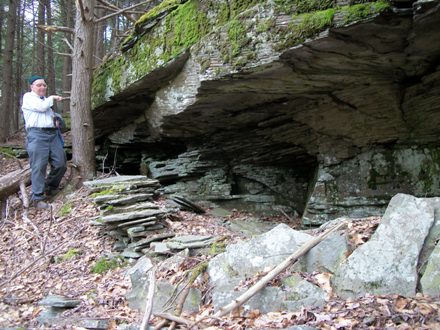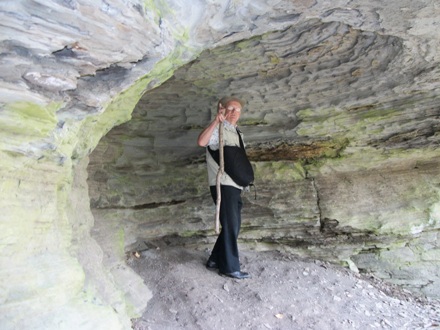
Mike Kudish at another sheltering overhang

David Rubenstein in Arkville ‘Indian’ cave
David Rubenstein, a student of Native cultures of the Northeast, wanted to know if the Historical Society had ever ascertained the location of any of these caves. Had artifacts or petroglyphs been discovered? Where was the “ancient village of Pakatakan” (spelled many different ways), as mentioned in Ethel Bussy’s History and Stories of Margaretville and the Surrounding Area?
A search of the Catskill Mountain News turned up a 1934 article that an Arkville cave had in fact yielded stone implements and arrow points for many years. The article said Roxbury lawyer Ralph Ives and sons Charles and Ralph Jr. unearthed a fire pit in this cave containing broken pottery, flint scrapers, a hammerstone, pestle, stone sinkers and other implements, along with animal bones made into needles and awls. Ives, who exhibited some of the items at a meeting of the Oneonta Kiwanis Club in June of 1934, claimed the material to be of Algonquin origin, perhaps dating back 2,500 years.
This type of activity is prohibited today, out of respect for the people who left behind traces of their lives, and of the stories they could tell us if left in place. Does anyone know where these artifacts may have landed?
Using information from the article, David Rubenstein, forest historian Michael Kudish and I went to have a look at the cave in early May, but we found nothing to indicate prehistoric occupation. The cave (actually an overhanging rock ledge) is spacious, but not the 30x20x8-foot high cave described in the newspaper account. Big enough to keep modern day hunters and woodwalkers out of the elements though, and clearly a few have taken advantage of that.
We checked out two other likely “Indian caves” and the surrounding forest. Dr. Kudish thinks the combination of tree species – white oak, mountain laurel, black birch, American chestnut and others, indicate the probability of repeated burns, suggesting that Indians may have found shelter in southeast-facing caves and cleared some of the prime flood plain land to grow summer crops.
Intriguing. We’ll likely never know for certain. But as woods walker and writer Peter Manning wrote following a recent tramp with Bovina historian Ray LaFever to “Indian Rocks” in that town, “It’s good to have timeless places that set our imaginations at play.”
If you have a similar story or would like to respond to this one, let us hear from you.
Diane Galusha
